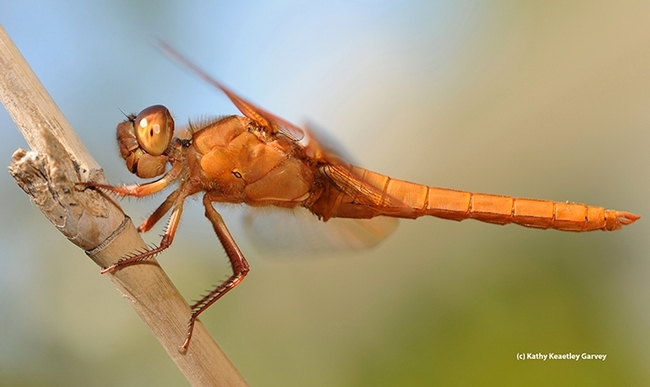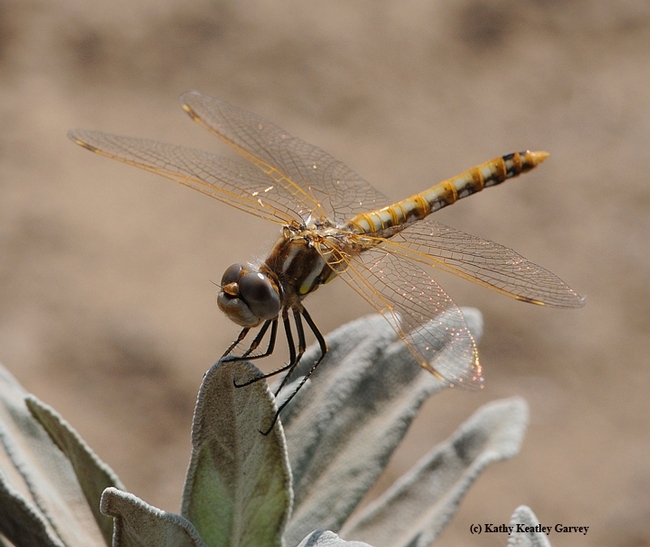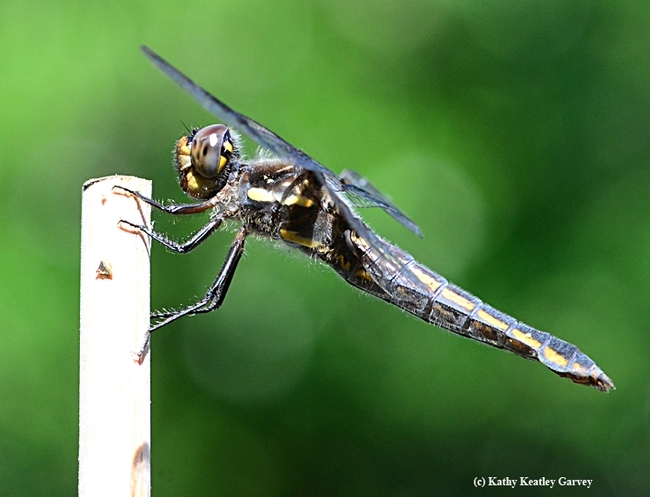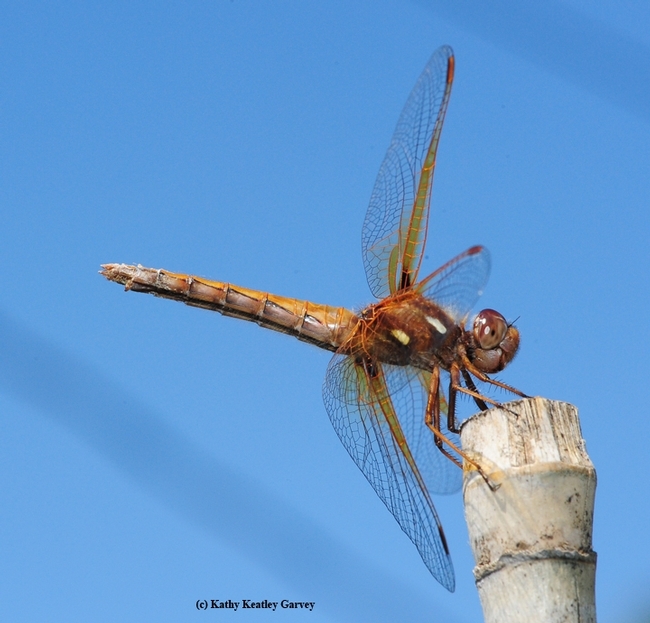
"What's that?" you ask. As you edge closer, it takes off. "Missed it!"
Well, you won't want to miss the Bohart Museum of Entomology's open house on Sunday, Sept. 20 when the theme centers around dragonflies and damselflies.
Dragonfly/damselfly expert Rosser Garrison of the California Department of Food and Agriculture (CDFA) will share his knowledge of dragonflies and damselflies---and showcase some of his global specimens. The open house, the museum's first of the 2015-16 academic year, is from 1 to 4 p.m. in Room 1124 of the Academic Surge Building on Crocker Lane, corner of Crocker Lane and LaRue Road, University of California, Davis. Admission and parking are free.
Did you know that their ancestors existed before dinosaurs did? And that fossil records show that they were the world's largest flying insects, some with wingspans measuring three feet?
“Dragonfly relatives existed before the onset of the dinosaurs---Triassic Period, 250 to 200 million years ago,” Garrison said. Pointing out that these gigantic dragonfly-like insects had wingspans of about three feet, he said that “there was about 20 percent more oxygen in the atmosphere than there is now and other giant insects occurred during that period.”
Garrison will show some of his “Oh, My” dragonflies and videos. “Dragonflies are such neat creatures,” he said. “They are considered beneficial since both larvae---all aquatic--and adults are predators. But one is called the ‘Bee Butcher' and has a reputation for eating honey bees.”
Some interesting facts he related about dragonflies:
- They have a primitive flight mechanism compared to other insects, bees, butterflies, beetles and flies.”
- They, at least many dragonflies, mostly mate on the wing.
- They are not poisonous and they do not sew up people's ears (“devil's darning needles”). However, one group of large dragonflies are called—appropriately—"Darners."
- Larvae have a neat prehensile foldable lower lip unique in insects; it is used for capturing prey like mosquito larvae or even small fish.
Garrison is a senior insect biosystematist in the CDFA's Plant Pest Diagnostics Branch, Sacramento. He identifies various potential invertebrate pests (such as grasshoppers, true bugs and terrestrial mollusks) entering California and determines if they are threats to agricultural commodities.
Garrison's research has resulted in more than 80 published papers dealing with dragonflies, pest insects and includes monographic works and book chapters on tropical ecology and insect systematics.
Garrison was the senior author of two recently published volumes, “Dragonfly Genera of the ew World. An Illustrated and Annotated Key to the Anisoptera” (2006), and “Damselfly Genera of the New World. An Illustrated and Annotated Key to the Zygoptera” (2010), both published by The Johns Hopkins University Press). He has also contributed chapters on invertebrate ecology for “The Food Web of a Tropical Rain Forest” (Chicago University Press, 1996) and “Manu. The Biodiversity of Southeastern Peru” (National Museum of Natural History, 1996).
He has served as the editor of Odonatologica, the quarterly journal of the Societas Internationalis Odonatologica, since January 1998. He has researched and collected dragonflies throughout much of the world, including Puerto Rico, Argentina and Costa Rica.
Garrison received two degrees from the University of California, Berkeley: his master's degree in 1974 and his doctorate in 1979. His doctoral dissertation was on “Population Dynamics and Systematics of the Damselfly genus Enallagma of the western United States (Odonata: Coenagionidae) 1979, published in 1984.
He joined CDFA in December 2004 after serving as a senior biologist/entomologist for Los Angeles County, where he identified all potentially important agricultural invertebrate pests entering the county, and provided insect identification services and advice on their control.
Following the dragonfly/damsel presentation, five other weekend open houses are scheduled:
Saturday, Dec. 5, 1 to 4 p.m.: “Keep Calm and Insect On.”
Sunday, Jan. 10 from 1 to 4 p.m.: “Parasitoid Palooza II”
Saturday, Feb. 13: Biodiversity Museum Day
Saturday, April 16, 10 a.m. to 3 p.m.: UC Davis Picnic Day
Saturday, July 31, 8 to 11 p.m.: “Celebrate Moths.”
The Bohart Museum, directed by Lynn Kimsey, houses a global collection of nearly eight million specimens, including 469 different species of dragonflies.
It is also the home of the seventh largest insect collection in North America, and the California Insect Survey, a storehouse of the insect biodiversity. Noted entomologist Richard M. Bohart (1913-2007) founded the museum.
Special attractions include a “live” petting zoo, featuring Madagascar hissing cockroaches, walking sticks and tarantulas. Visitors are invited to hold the insects and photograph them.
The museum's gift shop, open year around, includes T-shirts, sweatshirts, books, jewelry, posters, insect-collecting equipment and insect-themed candy.
The Bohart Museum's regular hours are from 9 a.m. to noon and 1 to 5 p.m. Mondays through Thursdays. The museum is closed to the public on Fridays and on major holidays. Admission is free. Parking is free on weekends.
More information on the Bohart Museum is available by contacting (530) 752-0493 or emailing bmuseum@ucdavis.edu. Tabatha Yang (tabyang@ucdavis.edu) is the public education and outreach coordinator.
Attached Images:

A red flameskimmer dragonfly, (Libellula saturata) perches on a bamboo stake. (Photo by Kathy Keatley Garvey)

Variegated meadowhawk (Sympetrum corruptum). (Photo by Kathy Keatley Garvey)

Widow skimmer (Libellula luctuosa). (Photo by Kathy Keatley Garvey)

Red-veined meadowhawk (Sympetrium madidum). (Photo by Kathy Keatley Garvey)